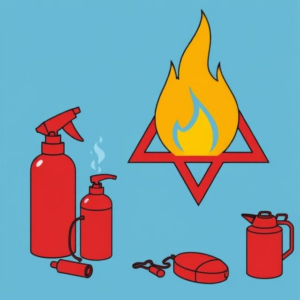Have you ever wondered what things are flammable in your home? From kitchen to garage, our households are stuffed with items that can easily set fire in seconds when misused or perhaps exposed to certain conditions. Most of these objects are so common that hardly anyone ever thinks of their potential dangers. Understanding the risks helps you protect your property and your loved ones from accidents.
What Things Are Flammable? Common Household Items That Can Ignite Quickly

If you’re wondering what things are flammable in your household, the answer might surprise you. Many seemingly harmless items can become dangerous under the right (or wrong) circumstances. Here are some of the most common culprits:
1. Cooking Oils and Grease
Cooking oils, broadly categorized as vegetable oil or olive oil, are necessary in most kitchens. But they are also among the most flammable materials in your home. Cooking oil becomes spontaneously combustible when overheated. Grease buildup on stovetops, ovens, or exhaust fans is equally hazardous as it can catch fire from high heat or a stray spark.
Always stay present while cooking and keep a lid or baking soda nearby to quickly smother an oil fire. Never use water, as it will only make the fire worse.
2. Paper Products
Stacked paper towels, newspapers, books, and cardboard boxes are very flammable and can serve as kindling to spread a small fire into a bigger one. This is particularly hazardous if they are stored close to heating sources such as radiators, space heaters, and stoves.
Keep at least three feet between paper products and all heat sources and do not stack them in areas that generate heat, such as attics.
3. Clothing and Fabrics
Dressing in natural fabrics such as cotton, wool, or linen means you are open to the high possibility of fire hazards with open flame. High temperature also exposes some kinds of synthetic fiber like polyester and nylon to bursting into flames or melting.
Keep fabrics away from candles, gas heaters, or cigarettes, and avoid drying clothing on heaters as they can easily catch fire.
4. Aerosol Cans
Aerosol cans like those found in hairspray, deodorants, and cooking sprays are often pressurized. Such cans carry inherent dangers as they contain flammable propellants. Under direct sunlight, in excess heat, or when exposed to flame, the pressure inside may build up and cause the can to explode.
Store aerosol cans in cool, dry places away from direct sunlight and never place them near stoves or fireplaces.
5. Alcohol-Based Products
Large quantities of alcohol are present in hand sanitizers, perfumes, nail polish removers, and some cleaning agents that are in fact very flammable. A tiny spark may ignite their vapors and fire bursts suddenly.
Cap these products tightly when not in use and avoid using them near an open flame.
6. Batteries
Lithium batteries that are commonly used in smartphones, laptops, and power tools. If damaged or overcharged or stored poorly, there is a significant risk of fire. They can self-heat and combust or explode.
Follow manufacturer guidelines for charging and storing batteries. Dispose of damaged batteries at designated recycling centers.
7. Cleaning Supplies
Household cleaners often contain ignitable chemicals such as ammonia or acetone. Their vapors can ignite if exposed to heat or flame, especially when vapors build up in enclosed, poorly ventilated spaces.
Store cleaning supplies in a well-ventilated area away from any heat sources, and avoid mixing chemicals that could react dangerously.
8. Wood and Sawdust
Notably, untreated wood does not have the capacity to ignite immediately, but, once ignited, it burns quite easily. On the other hand, sawdust does the opposite; it could catch fire supremely fast because of the fine particles forming larger surface areas where combustion occurs.
Avoid piling sawdust near heaters or machinery, and dispose of it properly after completing a woodworking project.
9. Candles
Although candles are designed to burn they can pose a serious risk when left unattended. A forgotten candle placed near a curtain or flammable decoration can cause a fire in no time.
Always extinguish candles before leaving the room and place them on stable surfaces away from anything that can catch fire.
When it comes to fire safety, even small changes can save lives. Now that you have a thorough understanding of what things are flammable in your household, take a few moments to assess your living space. Ensure flammable materials are stored safely, heat sources are used in prudent manners, and fire-stopping devices are provided.
Fire hazards are often hiding in plain sight, but with vigilance and proper precautions, you can minimize the risks and keep your home safe. Whether it is a bottle of cleaning spray or a pile of forgotten newspapers, whatever you do to reduce flammability will go a long way in protecting not just your property but also those you love most.
Previous